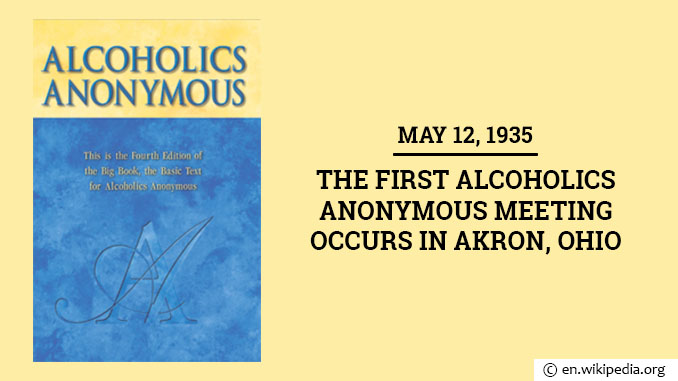The battle against addiction has taken many forms throughout the centuries, but none has had a more prominent effect in recent times than Alcoholics Anonymous. The twelve-step program centering on building communities of people to overcome the challenges of recovery together had its first unofficial meeting on May 12, 1935. Bill Wilson and Dr. Bob Smith — the two men gathered in Henrietta Sieberling’s Akron, Ohio home — would go on to found an organization which helps millions resume productive lives. The 1920s were good for the United States: despite a ban on the sale of alcohol, beer and spirits flowed liberally through American society in underground clubs and backwater distilleries. For Wilson and many other young men scarred and jaded by the horrors of World War I, liquor became a haven from the stresses of everyday life. Smith, 15 years Wilson’s senior, found the temptation to medicate with a drink a much easier alternative as he pushed his way through Rush Medical College and into private practice in Akron. Both men spent much of the decade finding ways to barely hold on to a semblance of a normalcy in order to support families, ably providing shelter and food for their wives and children, if not true companionship and love. By the dawn of the 1930s, Wilson and Smith were among those perceived by the American public as being of “low moral character.” Despite the stigma associated with addiction, the two diligently pursued solutions to help them manage the process of ending alcohol’s grip on their lives by availing themselves of the care available at the time: hospitals, psychiatric institutions or charities. By Smith’s own count, he submitted himself to more than a dozen such treatment options over the years, often falling back into drinking within a matter of days — and hiding it as best he could from his wife. Living in New York City during 1934, Wilson fought against his addiction almost continuously. Though given hope by Dr. William Silkworth that he faced a medical condition instead of a mere character flaw, Wilson relapsed over and over while under Silkworth’s care at Charles B. Towns Hospital. A visit from an old friend, Ebby Thacher, ended up giving him the impetus to move forward. Taken aback by Thacher’s newfound faith and desire to help him loose the shackles of alcoholism, Wilson searched out his former drinking buddy at the Calvary Rescue Mission run by the Oxford Group, a Christian organization. Immersing himself in the theories of psychologist William James, who proposed the concept of vast positive results from immense personal tragedy, Wilson became convinced the Oxford Group would help him regain control of his life. After meetings with other “Groupers,” he gathered with fellow former alcoholics to discuss how to reach others still battling the desire to drink. Almost by chance, Wilson ended up in Akron on business on May 12, 1935. Feeling the temptation to belly up to a bar and drown himself in beer again, he began calling local ministers in search of an alcoholic to help talk him off the ledge. Connected with Sieberling, an Oxford member who had been pouring herself into Smith with the intent of helping him achieve sobriety, Wilson arrived at her home for a meeting. Smith agreed to sit down with the man from New York City, but only for 15 minutes. The two spoke for more than six hours. Wilson moved into the Smith family home to support the doctor’s recovery, joining the husband and wife for morning readings from the biblical book of James. Four weeks later, Smith had his last drink, becoming the first person Wilson helped come to sobriety. Once a skeptic, Smith turned into a partner, talking with Wilson about the framework for a simple plan to guide even the worst alcoholics back to a healthy life. The two kept in constant contact over the next two years, forming groups in Akron and New York City to provide a support structure for those seeking to be sober. In 1939, Wilson and Smith wrote Alcoholics Anonymous, a book describing the means by which an addict could win the battle to defeat temptation. By knitting together a group of people committed to the Twelve Steps Wilson believed necessary for lasting sobriety, he felt AA was able to achieve a better success rate than the existing systems in place. Even the mention of alcoholism as a disease instead of a moral failing helped many attack the problem with new vigor. Following more than 75 years of meetings, AA has helped more than 2 million people face down addiction and spawned similar programs for those enslaved by narcotics and other phenomena. Though some regard its methods as antiquated, the fact remains Wilson and Smith shifted the course of treatment for alcoholism by focusing on psychological factors, paving the way for others to succeed in untold ways. Also On This Day: 1588 – Henri of Guise takes Paris as King Henri III flees the capital during the French Wars of Religion. 1820 – Florence Nightingale, famed British nurse during the Crimean War, is born in London. 1932 – The body of Charles Lindbergh’s son, Charles Jr., is found in Hopewell, New Jersey. 1949 – The Soviet blockade of Berlin comes to an end. 2008 – A magnitude 8.0 earthquake kills 69,000 in Sichuan, China.
May 12 1935 – The First Alcoholics Anonymous Meeting Occurs in Akron, Ohio
The battle against addiction has taken many forms throughout the centuries, but none has had a more prominent effect in recent times than Alcoholics Anonymous. The twelve-step program centering on…
840
